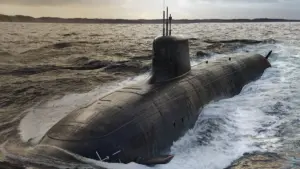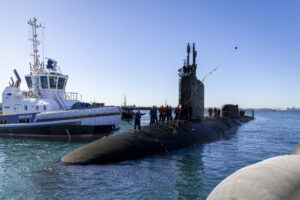The Australian minister for defense industry this week confirmed the new SSN-AUKUS submarine will use a version of the current submarine combat system and that his government’s plan to sequence production of the new AUKUS attack submarine after the U.K. will optimize efficiencies.
Speaking to reporters at the National press Club of Australia on Nov. 28, Minister Pat Conroy argued procuring nuclear-powered submarines for Australia is increasingly necessary, but admitted the task will not be simple.

“A critical aspect of this national endeavor is developing and implementing the acquisition strategy to build the new submarines. This will be the greatest industrial undertaking ever attempted in Australia both in scale and technical complexity.”
He said the Australian side of AUKUS is expected to create about 20,000 highly skilled jobs domestically.
Under the optimal pathway of the tripartite AUKUS project unveiled earlier this year, the U.S. plans to sell three to five used and new nuclear-powered Virginia-class attack submarines (SSNs) in the 2030s before Australia ultimately receives its first SSN-AUKUS submarine in the early 2040s.
Conroy said a viable and realistic acquisition strategy for AUKUS is “critical.”
He highlighted that the U.K. Royal Navy will start building the SSN-AUKUS first, helping the less experienced partner gain lessons learned from initial production.
“Unlike our experience with [Collins-class] where Australia was left operating a unique design with no existing parent industrial base to draw from, SSN-AUKUS will provide shared experience in operating the platform and a shared industrial base for maintenance and sustainment,” Conroy said.
He added that Australia sharing a design with the U.K. “clearly avoids the first challenge the Collins faced. SSN-AUKUS will be a common platform operated by both the U.K. and Australia with two production lines – one based in Barrow-in-Furness in the U.K. And one based in Osborne in South Australia.”
Conroy confirmed the partners are reducing Australia’s program risk by staging their SSN-AUKUS production after the U.K. starts building its first hull.
“The U.K. will bear the first-of-class risks common in defense procurement, especially in naval construction,” he said.
The first U.K. SSN-AUKUS boat is expected to finish production in the late 2030s, while Australia plans to deliver its first SSN-AUKUS in the early 2040s.
This matches statements from Capt. Lincoln Reifsteck, the AUKUS integration and acquisition program manager at Naval Sea Systems Command, during the Naval Submarine League annual symposium earlier this month (Defense Daily, Nov. 13).
“We want those in sequence…U.K. certainly has experience as a nuclear submarine building country, so we can cut down on lessons and challenges to cut down on the overall construction,” Reifsteck said.
Conroy said the Australian government aims to complete production on SSN-AUKUS vessels at a rate of one every three years.
“On current timing at least one, if not two, Royal Navy submarines will be in the water before our first. This arrangement will also spread the risk over two production lines and create efficiencies. Economies of scale will also be generated by producing parts for a fleet of submarines much greater than the production run of six Collins submarines.”
He said one lesson the government learned from the Collins-class procurement experience is to not also build a totally new combat system alongside a new submarine hull.
“While the SSN-AUKUS will be new, it’s envisaged that the combat system will be an evolved version of the current AN/BYG-1 combat system, which is already in service in the Collins and Virginia-class submarines,” Conroy said.
Lockheed Martin [LMT] is the prime contractor for the AN/BYG-1 combat system, with General Dynamics [GD] the integrator for U.S. submarines. The new version of AN/BYG-1 is set to be co-developed by Australia and the U.S.
Conroy said SSN-AUKUS aims to field a vertical launch system and torpedo tubes to field systems like the Mark 48 heavyweight torpedo while sustainment for these systems is being considered from the start.
“Sustainment needs are being considered from day one of the process, including what parts we will need, when we will need them and where they will need to be,” he said.

Conroy affirmed the importance of a larger international submarine sustainment capability in light of issues the government had with the Collins-class boats.
He said an effect of SSN-AUKUS is “that by operating a common class of submarines will not only increase demand, we’ll also create stable and continuous demand in both the acquisition and sustainment phases of the project.”
Ultimately, the three partners hope to together identify the best ways to share work that creates a “capable, efficient and integrated industrial base across the three nations.”
Conroy reiterated all Australia’s submarines, except the nuclear reactor module, will be built domestically because “the entire point of AUKUS Pillar 1 is to expand and grow the industrial base of all three nations so that Australia can join the U.S. and U.K. in building nuclear-powered submarines.”
He said they collectively aim to increase nuclear-powered submarine shipyard production from three shipyards across the U.S. and U.K. to four when adding Australia.
Ultimately, Conroy compared the previous plan for new diesel-electric submarines to SSN-AUKUS as a choice to spend over $235 billion for a non-nuclear-powered capability to a “moderately larger investment to acquire a regionally superior submarine.”
Conroy argued SSN-AUKUS is useful for Canada, in part, because nuclear-powered submarines are particularly useful for Australia’s large distances to station.
“Due to their stealth and destructive capability, submarines, especially the most capable nuclear-powered ones, provide an asymmetric advantage. They allow a middle power like Australia to place doubt in nations with much larger militaries. Their mere existence imposes uncertainty into a potential opponent’s plans,” Conroy said.
Notably, he said due to their speed and endurance, a smaller number of nuclear-powered attack submarines (SSNs) can be as effective as a larger number of diesel-electric submarines, like Australia’s current Collins-class boats. He said each nuclear-powered attack submarine “can be seen as the equivalent of two diesel electric submarines in terms of patrol coverage.”
Conroy argued these SSN efficiencies are needed because Australia has to steam for longer distances to get on station to protect its waters.
“This is one of the key reasons why people arguing that diesel electric submarines are the right capability for Australia are misguided. Australia is the only nation in the world that requires diesel electric submarines to transit thousands of kilometers before they even reach their patrol area. Our diesel electric submarines need to use the greater part of their fuel capacity for these transits, limiting their time on station. By contrast, nuclear-powered submarines are not limited by fuel. They can get to where they need to go faster, meaning they can spend more time on station.”